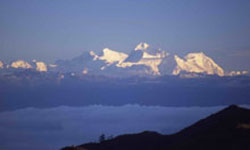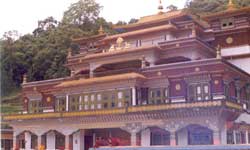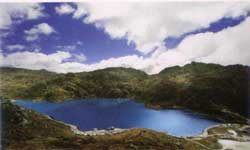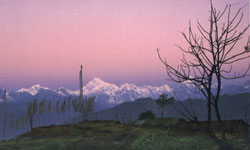|
|
 |
Sikkim |  |
| Sikkim
is legendary for its peaceful nature and simplicity. Famous for Kanchenjunga,
the third highest mountain in the world at 8586m, the mountain state of
Sikkim offers tremendous variety of plant and wildlife besides a diverse
ethnic mix of people with rich cultural tradition. One of the smallest
states in India, Sikkimese life is centered on Gangtok,
the state capital. Rising 300m above the Indian plains, Sikkim borders the edge of the Tibetan Plateau on its north and Nepal on its east. Although it was historically a Buddhist kingdom, the Hindus currently represent the majority. The state has close links with Tibet and it's the home of over 250 monasteries of mostly the Nyingma-pa sect. |
|||
 |
Sikkim
is rich with wide variety of flora and fauna. More than 450 varieties
of orchids, over 600 species of butterflies, 500 species of birds along
with red pandas, snow leopards and other animals can be seen in the state.
The largest collection can be seen at the Kanchenjunga National Park which
covers an area of 850 square kilometers. Capital: Gangtok, the capital of Sikkim lies on a ridge with fine views of the Kanchenjunga. |
||
| Culture:
The state's cultural life is related to Tibetan traditions. The Namgyal
Institute of Tibetology in Gangtok has one of the largest collections
of Tibetan books in the world. Many Buddhist monasteries are repositories
of artistic treasures, including wall paintings, tankas, and bronze images. Buddhism is an integral part of Sikkim and its culture, and many of the recommended trips around Gangtok have a monastery as their ultimate destination. The monasteries that are closest to Gangtok are Enchey, Rumtek and Phodong. Click here to see a list of monasteries of Sikkim. |
|||
 |
Occupation:
Tourism and agriculture is the basis of the Sikkim economy. Sikkim is
India's major producers of cardamom. Sikkim`s forests have great economic
value in sawn timber and wood pulp. Sikkim`s cotton and wool weaving,
carpets, rugs, blankets, and bamboo work is also well-known. Climate: The annual rainfall varies from 50-200 inches (mostly during May-October), and perennial snow in the upper levels often accumulates to a thickness of 30m. Ideal time to visit the state is between March to late May and between October to December. The best times to see orchids in bloom are April-May, July-August, and November. |
||
|
Accommodation in Gangtok |
|||